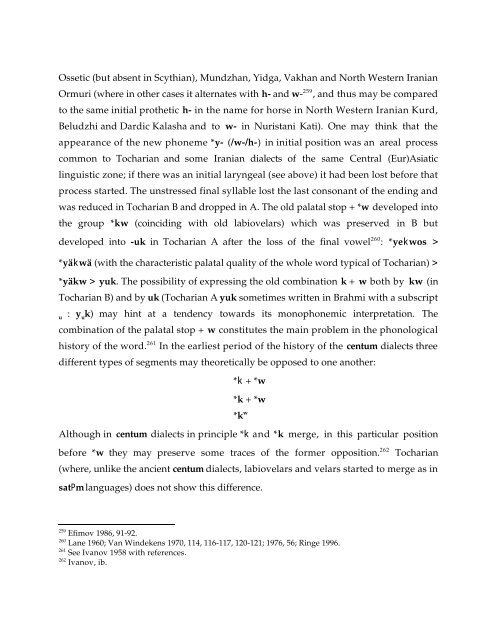Comparative Notes on Hurro-Urartian, Northern Caucasian
Comparative Notes on Hurro-Urartian, Northern Caucasian
Comparative Notes on Hurro-Urartian, Northern Caucasian
You also want an ePaper? Increase the reach of your titles
YUMPU automatically turns print PDFs into web optimized ePapers that Google loves.
Ossetic (but absent in Scythian), Mundzhan, Yidga, Vakhan and North Western Iranian<br />
Ormuri (where in other cases it alternates with h- and w- 259 , and thus may be compared<br />
to the same initial prothetic h- in the name for horse in North Western Iranian Kurd,<br />
Beludzhi and Dardic Kalasha and to w- in Nuristani Kati). One may think that the<br />
appearance of the new ph<strong>on</strong>eme *y- (/w-/h-) in initial positi<strong>on</strong> was an areal process<br />
comm<strong>on</strong> to Tocharian and some Iranian dialects of the same Central (Eur)Asiatic<br />
linguistic z<strong>on</strong>e; if there was an initial laryngeal (see above) it had been lost before that<br />
process started. The unstressed final syllable lost the last c<strong>on</strong>s<strong>on</strong>ant of the ending and<br />
was reduced in Tocharian B and dropped in A. The old palatal stop + *w developed into<br />
the group *kw (coinciding with old labiovelars) which was preserved in B but<br />
developed into -uk in Tocharian A after the loss of the final vowel 260 : *ye´kwos ><br />
*yä´kwä (with the characteristic palatal quality of the whole word typical of Tocharian) ><br />
*yäkw > yuk. The possibility of expressing the old combinati<strong>on</strong> k + w both by kw (in<br />
Tocharian B) and by uk (Tocharian A yuk sometimes written in Brahmi with a subscript<br />
u : yuk) may hint at a tendency towards its m<strong>on</strong>oph<strong>on</strong>emic interpretati<strong>on</strong>. The<br />
combinati<strong>on</strong> of the palatal stop + w c<strong>on</strong>stitutes the main problem in the ph<strong>on</strong>ological<br />
history of the word. 261 In the earliest period of the history of the centum dialects three<br />
different types of segments may theoretically be opposed to <strong>on</strong>e another:<br />
*´k + *w<br />
*k + *w<br />
*k w<br />
Although in centum dialects in principle *´k and *k merge, in this particular positi<strong>on</strong><br />
before *w they may preserve some traces of the former oppositi<strong>on</strong>. 262 Tocharian<br />
(where, unlike the ancient centum dialects, labiovelars and velars started to merge as in<br />
satPm languages) does not show this difference.<br />
259 Efimov 1986, 91-92.<br />
260 Lane 1960; Van Windekens 1970, 114, 116-117, 120-121; 1976, 56; Ringe 1996.<br />
261 See Ivanov 1958 with references.<br />
262 Ivanov, ib.





